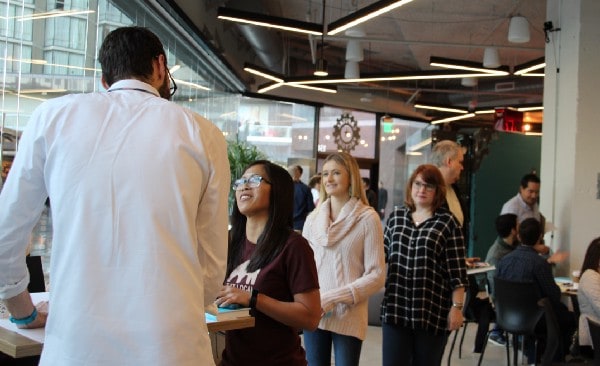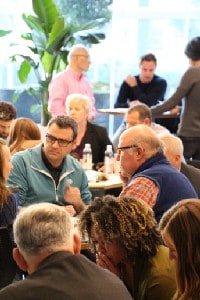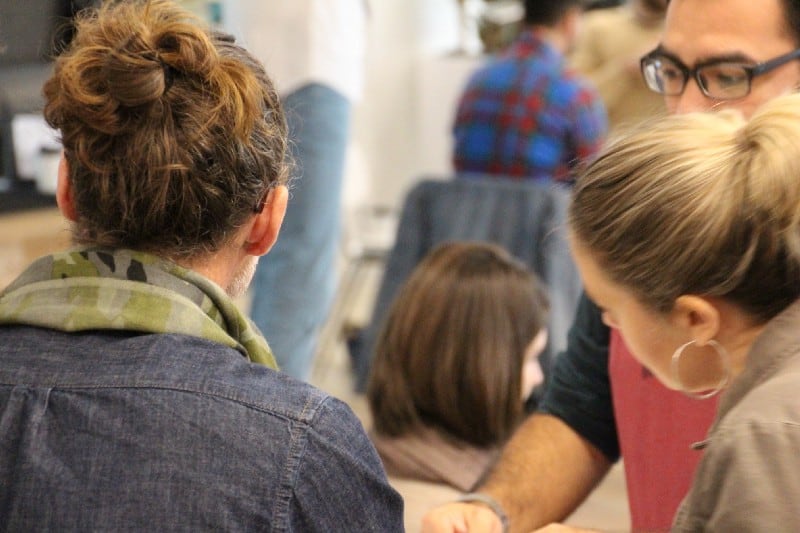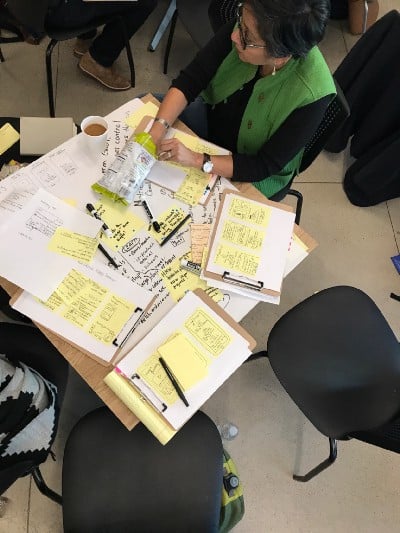
After several months of planning and organization Jake Knapp arrived in the lobby of the Omni, and after a few hugs, we began organizing the room. We hosted the event in Capital Factory’s 1st floor Voltron space. Capital Factory was a great partner and a stellar event space. When we arrived, Voltron was set up in theatre style seating, and we wanted to assemble the workshop into teams, so we began to move the tables and chairs to create 4–5 person pods. Each group got an easel board post-it in place of a whiteboard.


Once the room was set up, and we were ready to let folks in the door there was quite a line wrapping through the lobby of the hotel. Luckily John and Anna are pros, and they got folks through quickly.

After checking in and receiving their supplies attendees got their books signed by Jake. This was also an opportunity for everyone get a tiny bit of one-on-one with Jake, whose fun and engaging personality is infectious for all.



Intros
Jake kicked off the workshop with some brief intros. First, he thanked our food sponsors: Herbs & Harmony, Rutamaya coffee, and Clean Cause beverages. Then he gave big thanks to Voltage Control and asked me to make a few brief announcements. I let everyone know about a special discount for Respondent.io, the Austin Design Sprint Meetup, and an upcoming talk by Phil Gilbert of IBM Design. Finally, he introduced Dee Scarano, from AJ&Smart who came with Jake to assist him.
Origin Story
After intros, Jake began a story about the origin of Design Sprints, which not only takes us back to Google when he was working on Hangouts but way back to Microsoft when he was on the team building Encarta.

Jake shared with us the familiar story of the Encarta team not involving marketing until the very end of the project. When marketing released the Encarta box the main feature, which they spent all their time on, was in the smallest print on the box. Apparently, there was a disconnect. Something needed to change.
With the desire to design the perfect week, Jake was inspired by the way you think about your job when you first start a new role. Your calendar is free, and your options are endless. He asked himself, what if we could treat the first week of any project as if it were the first week on the job?
He also asked himself why he, as a designer, had an unfair advantage due to his ability to draw/design. Could there be a way to test risky ideas from folks that didn’t know how to draw, thus allowing everyone to participate in the crafting of the future?
Most people assume that speed is the critical ingredient to a Sprint as we are making huge leaps forward in merely five days. Jake points out that gathering everyone together for five consecutive days of intense work is more important to him that the speed.
“Fast is important — but five days is more about being deep together and keep context and get big results.”
In almost every endeavor in life, school, sports, music, dance, and drama, we practice and rehearse. However, in the workplace, we don’t always have this practice mode. We are continuously at the main event. Practice lets you take a risk in private, and failure doesn’t cost you that much. Design Sprints are practice for product releases.
I often talk about the benefits of using design sprints inside of a build and learn loop. MVP is a smart way to built products, however, even with today’s fancy tools, the MVP can take a long time. Inserting design sprints into the build-test loop helps shorten the overall cycle of learning.


Facilitator Tips
Jake sprinkled lots of great facilitation tips throughout the workshop. He even used these facilitation hacks on the audience during the workshop; then he would stop and point out what he just did. One example of this is when he sets expectations, even when they may seem obvious. He made sure to remind us that we were here to learn the method and not to get too hung up on solving the problem because it is a fun problem after all.
“Today will be frustrating- you will get into this fake activity, and I’ll rip you out, you’ll never get enough time to finish” — Jake Knapp
Other facilitation tips
- Ask for permission to facilitate to set expectations from the start.
- Say pause not stop; “I think we should pause this for a sec.”
- When conversations get out of hand, use Note & Vote or defer to the decider.
- Telling the team “This is going to be hard,” makes it seem easier.
- Repeat an instruction twice —The first one is throw away to get attention.

High Fives!
Who doesn’t love a high five? As Jake transitioned from the history lesson to the “activity” portion of the workshop, he asked for a volunteer to demonstrate the execution of a perfect high five. As you may already know, you watch the elbow. Jake pointed out that Design Sprints are like watching the elbow. They help you stay focused on the import thing, not necessarily the obvious thing.


Magic Penny
Magic Penny is the name of the fake company that each group would use as the foundation for each of the Design Sprint exercises. This fictitious app connects to your bank account and automatically decides how much money it should transfer to your saving account. No more worrying about overdrafts or having to remember to move money into savings manually.


No Device Rule
The no device rule is an essential part of a successful Sprint. Don’t be tempted to allow the more senior folks to bulldoze through this provision. They are the ones that will benefit the most from this rule. Even when you have the best of intentions, and are only taking notes, it sends a confusing signal to the team. If someone needs to take a call or send some emails, politely ask them to step out of the room.
Note: Power gloves are exempt from the no device rule and always allowed.
GOAL
The first step on Day one is setting a goal. Setting the goal helps us frame where we are headed and keeps us focused on our overall business objective. Since Jake is using a predetermined example for this workshop, he has constructed it in a “cooking show” style. He has already decided the goal for us and after a brief bit of discussion presents it to us.

Questions
After selecting a goal, we start to get pessimistic and ask ourselves, what will stop us from reaching our goal? Throughout the workshop, Jake shares the latest tweaks and updates to the process that aren’t in the book. One such tweak is to write the pessimistic questions as Yes/No questions. Then on day-5 when we are interviewing the testers we can use the questions as a rubric to score each tester.





HMW
After getting pessimistic, it’s time to interview our expert(s) and write our “How Might We” (HMW) statements on sticky notes. Dee Scarano, Product Designer and Sprint Master @ AJ&Smart, was our expert and Jake interviewed her in front of the entire workshop. During the interview, we all wrote HMW cards. Writing the HMW statements keeps our minds from straying and helps us stay focused on active listening. The speaker feels more comfortable when interviewers are taking notes on what they say.
Finally, we sort the HMW stickies into affinity groups. Sorting helps to organize the HMW for easier voting and will identify duplicates in the process. It also forces everyone to read all the HMWs.


Map
After presenting an example map to us, Jake demonstrated how to draw maps. Starting with a list of users on the left and the end goal on the right, begin drawing out the journey that each user takes as they approach the goal. Another technique not provided in the book is to break up the map up into 3 sections: Discover, Learn, Start. After creating the map, we returned to cooking show tactics as Jake tells us which moment to circle for our target.
“I’ve never been happy with the map; it never feels right; it never matters. If you are doing it, you are doing it right.”
Maps don’t have to be perfect, you just have to get through it and learn. The map is going to be messy. The important thing is to do it. The process will uncover what you need to discover. Once your map is complete, you’ll select a target. Your goal is to locate the place you can exploit; you are looking to find the weakness in the Death Star. Teams usually focus on the hard stuff; they want to figure out the heart of it. The best target is somewhere to the left of the hard stuff; facilitators can pull the focus back to the left.



Lunch
Vegan chef Taylor Green, of Herbs and Harmony, delivered a delicious culinary treat for us. Serving health foods low in sugar and high in protein will ensure that you have the brain fuel to do critical thinking and the energy to sustain you through the day without crashing.


Demos
Lightning demos are used to share analogous inspiration to get our creative juices flowing. We write down our favorite examples alongside the sprint questions and our favorite HMWs to help inspire our solution sketches.


Crazy 8s
Crazy 8s is a rapid-fire idea generation exercise. It is called crazy due to the speed and not because you are expected to come up with crazy ideas. The speed forces you to stop second-guessing yourself and allow your subconscious to pour onto the paper.

Solution Sketches
Solution sketches are intended to be done in quiet. It is vital that we sketch alone together. While the group setting and no device rule keeps us focused on the task at hand, the individual work allows us to explore our own thoughts.
“Your talking. It’s a secret. Don’t give it away.”












Art Museum
Each team found a blank wall space and taped up their sketches on the wall. Team members walked the line of sketches and read through each one. They then placed dot stickers on the parts that they liked the most. These dot stickers created a heat map to indicate ideas that were the most popular. Dot voting should be done in silence, during the session I laughed out loud as Jake said: “You’re talking, you’re doing it wrong.”



Speed Critique
Using the heat map as a guide the facilitator walks through each sketch describing the ideas that got the most votes. A helper is recording these ideas using a headline for each to capture the big idea. These headlines are written using the larger dry-erase marker on post-it notes and placed above the sketch.



Winning Sketches
After completing the voting process and the deciders cast their binding vote, Jake asked each team to bring their winning sketch to the front and lay them on the stage.


Sketch Review
Jake went through each winning sketch one by one and read out the highlights. It’s impressive to watch him rapid-fire analyze the sketches, cracking jokes as he goes. It’s heaps of fun. You can even see him cracking himself up.


Prototyping
Instead of jumping straight into building an MVP we produce a realistic facade and test it with five carefully recruited real-world customer. Our goal is to create a “movie set”; something that is convincing enough that testers will believe it is the real thing.

Research
Finally, Jake presented the research portion of the design sprint which involves interviewing five users to get their reactions to the prototype. This video is an excellent overview of the “5 act interview format”. Anybody can run these interviews. It takes practice to become totally natural. However, if you study the material beforehand, the ideas and techniques will be fresh enough in your brain that you can pull it off.
The 5 act interview format:
- Friendly welcome
- Context questions
- Introduction to the prototype
- Tasks
- Quick debrief

Q & A
At the end of a long day, Jake finally takes a seat and opens the floor to the audience to ask questions. He also invited Dee and me to grab a mike and help answer questions.

I haven’t gotten survey results back yet, but everyone I’ve spoken to had an absolute blast at the workshop. I know I did! I hope I’m able to bring Jake back to Austin, or perhaps to another city in Texas. If you are interested, email me at douglas@voltagecontrol.co.


Voltage Control specializes in Design Sprints, and we facilitate Sprints in Austin, Houston, San Antonio, and Dallas. Please email Douglas at douglas@voltagecontrol.co if you are interested in having us facilitate your Sprint, coach your team on how to run an effective Sprint, or are curious to learn more about how a Sprint might help your company or product.
If you are in or near Austin, visit us at the Austin Design Sprint meetup. Each month we have a guest speaker share their experience participating in a Design Sprint. If you would like to be a future speaker, please email me.


